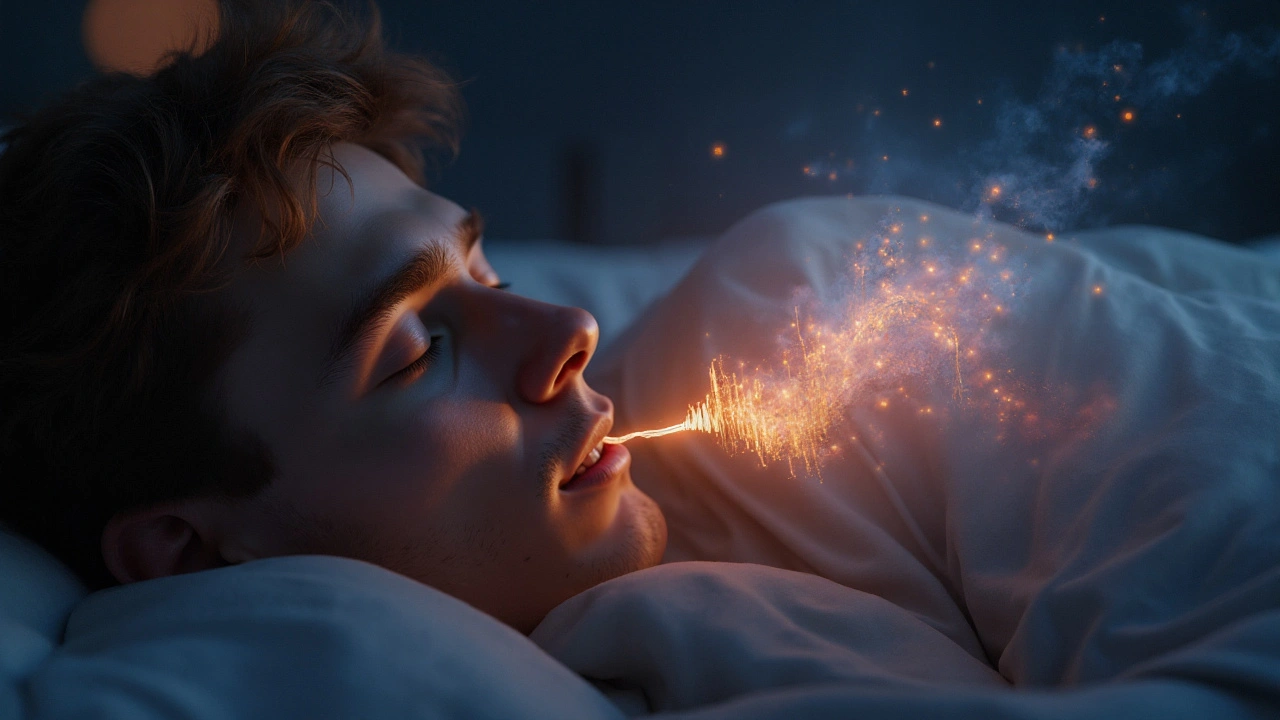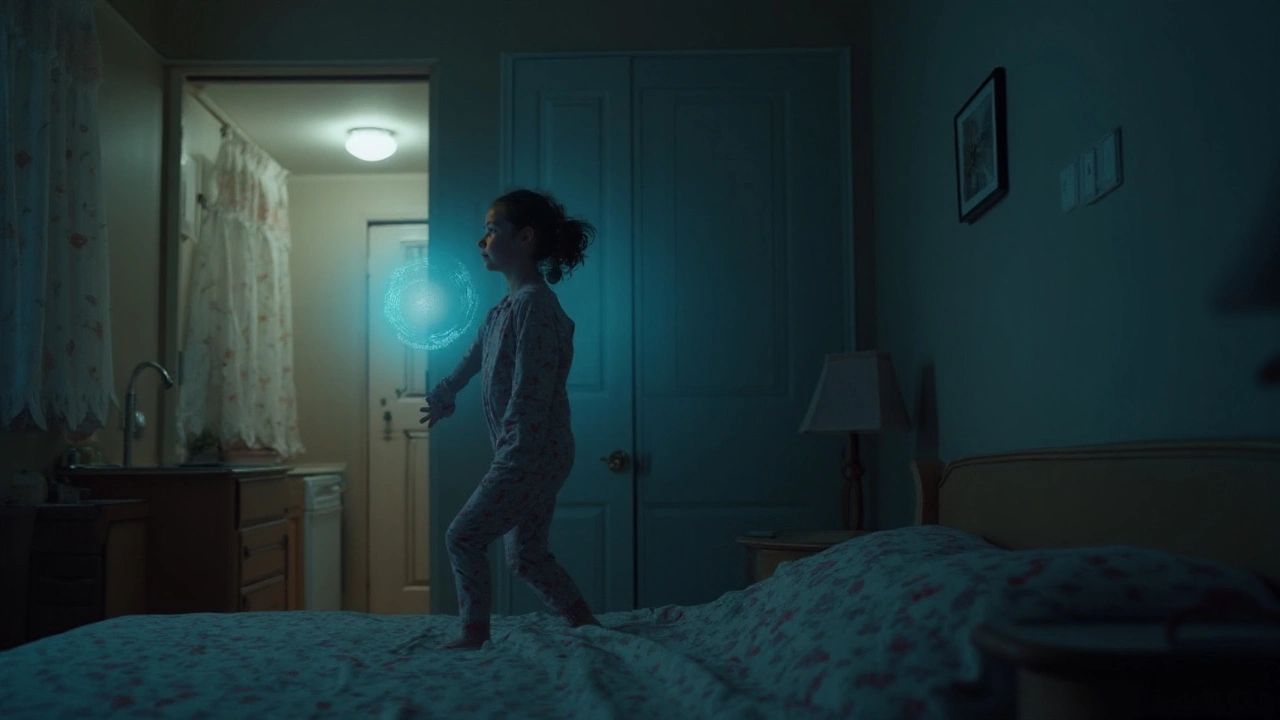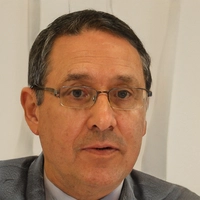Quick Take
- REM sleep makes up about 20‑25% of adult sleep and is marked by vivid dreaming and muscle atonia.
- Sleepwalking (somnambulism) and sleep talking (somniloquy) are classified as parasomnias that usually arise from non‑REM (NREM) sleep, but REM can modulate their occurrence.
- Reduced arousal thresholds and disrupted motor inhibition during REM increase the chance of mixed‑stage events.
- Polysomnography reveals characteristic EEG patterns that help differentiate pure REM phenomena from NREM‑linked parasomnias.
- Managing stress, sleep hygiene, and targeted therapies can lower the frequency of both sleepwalking and sleep talking.
What is Rapid Eye Movement (REM) Sleep?
Rapid Eye Movement (REM) Sleep is a sleep stage characterized by low muscle tone, vivid dreaming, and rapid eye movements, typically occupying 20‑25% of total sleep time in adults. During REM, the brain exhibits an EEG pattern resembling wakefulness, while the body experiences atonia due to inhibition from brain‑stem nuclei.
Key attributes of REM sleep include:
- Duration: 90‑120 minutes per sleep cycle, increasing toward the morning.
- Neurochemistry: High acetylcholine, low norepinephrine and serotonin.
- Physiological markers: Irregular respiration, increased heart rate variability, and burst suppression of skeletal muscle activity.
REM vs. Non‑REM (NREM) Sleep: A Side‑by‑Side Look
| Attribute | REM Sleep | Non‑REM (NREM) Sleep |
|---|---|---|
| EEG Pattern | Low‑voltage mixed frequency (similar to wakefulness) | High‑voltage slow waves (delta activity) |
| Muscle Tone | Severe atonia (muscle inhibition) | Gradual reduction, but generally preserved tone |
| Dream Content | Vivid, narrative, emotionally intense | Fragmented, thought‑like, less recall |
| Arousal Threshold | Relatively low; external stimuli can trigger micro‑awakenings | Higher; deeper sleep makes awakening harder |
| Association with Parasomnias | Less common, but REM‑related behaviors (e.g., REM sleep behavior disorder) illustrate motor disinhibition | Primary source of sleepwalking and sleep talking episodes |
Motor Inhibition in REM: The Role of the Brain Stem and Thalamus
The brain‑stem thalamus is a relay hub that filters sensory input during sleep. In REM, the sublaterodorsal nucleus and ventromedial medulla suppress spinal motor neurons, creating the atonia that keeps us from acting out dreams. When this inhibition fails-as seen in REM sleep behavior disorder-the dream enactment can mimic sleepwalking behaviors.
Similarly, the arousal threshold represents the ease with which external or internal stimuli can interrupt sleep. REM’s relatively low threshold means brief awakenings are more likely, which can blend the boundaries between REM and NREM, producing mixed‑stage parasomnias.
Parasomnias Overview: Sleepwalking and Sleep Talking
Sleepwalking (somnambulism) is a complex behavior arising from NREM Stage 3 (slow‑wave) sleep. The individual may sit up, walk, perform activities, and have limited or no recall. It typically occurs in the first third of the night when deep NREM predominates.
Sleep talking (somniloquy) involves vocalizations ranging from mumbling to coherent sentences, also emerging mainly from NREM sleep. Episodes can happen at any point of the night but are more frequent during lighter NREM stages.
Both parasomnias share risk factors such as sleep deprivation, stress, fever, alcohol, and certain medications. Genetic predisposition accounts for up to 40% of cases, indicating a heritable component.
How REM Influences Sleepwalking
Although classic sleepwalking is rooted in NREM, research shows that fragmented REM can lower the arousal threshold, allowing NREM‑generated motor activity to “spill over” into the lighter portions of REM. When REM atonia is incomplete-often due to sleep deprivation or certain antidepressants-the brain may permit limited motor output, creating hybrid events that resemble sleepwalking.
A 2022 longitudinal study of 312 adults reported that individuals with a higher proportion of REM‑NREM transitions experienced a 22% increase in nocturnal ambulation episodes compared to those with stable sleep architecture. The authors linked this to “REM intrusion” where brief REM episodes interrupt deep NREM, triggering partial arousal without full cortical wakefulness.
Clinical implication: monitoring REM stability with polysomnography can help identify patients whose sleepwalking may be REM‑modulated, guiding interventions such as melatonin supplementation to stabilize REM cycles.

How REM Influences Sleep Talking
Sleep talking can surface during REM when the vocal cords are not fully inhibited, especially in children and adolescents. In REM, the limbic system is highly active, fostering emotional narratives that may manifest as speech. When REM atonia is imperfect-common in people with obstructive sleep apnea-the airway remains partially open, allowing phonation.
One polysomnographic series (n=88) found that 34% of REM‑related vocalizations were intelligible sentences, whereas NREM vocalizations were mostly nonsensical sounds. The study highlighted a correlation between REM‑stage micro‑arousals and increased speech frequency.
From a therapeutic angle, treating underlying REM disruptions (e.g., using CPAP for apnea) reduces REM‑related speech by up to 40%.
Diagnosing Parasomnias: The Power of Polysomnography
Polysomnography is an overnight sleep study that records EEG, EOG, EMG, respiratory flow, and limb movements. It provides the gold‑standard data for distinguishing pure NREM parasomnias from REM‑influenced events.
Key diagnostic markers include:
- EEG delta bursts indicating deep NREM during a walking episode.
- EMG spikes that suggest loss of REM atonia.
- EOG patterns confirming rapid eye movements at the onset of vocalization.
When a clinician observes mixed EEG signatures-slow waves intermixed with REM‑like low‑voltage activity-it signals a transitional parasomnia that may require tailored treatment.
Managing Sleepwalking and Sleep Talking
Effective management blends lifestyle tweaks with targeted medical approaches:
- Sleep Hygiene: Keep a consistent bedtime, limit caffeine after 2p.m., and create a cool, dark sleeping environment.
- Stress Reduction: Mindfulness, progressive muscle relaxation, or short evening walks can lower nighttime arousals.
- Medication Review: Antidepressants that suppress REM (e.g., SSRIs) may increase NREM parasomnias; discuss alternatives with a physician.
- Melatonin Supplementation: Low‑dose melatonin (0.5‑3mg) before bedtime stabilizes REM onset, reducing REM‑NREM transitions.
- CPAP Therapy for obstructive sleep apnea: Improves REM breathing patterns, cutting down REM‑related speech.
- Safety Measures: Secure windows and stairs, use bed alarms, and consider a sleeping partner’s observation to prevent injuries.
In refractory cases, clonazepam (0.5mg) before bed has shown success in dampening both NREM and REM motor disinhibition, but long‑term use demands careful monitoring.
Related Concepts and Next Steps
Understanding REM’s impact opens doors to broader topics such as dream recall, circadian rhythm disorders, and nightmare management. Readers interested in how melatonin influences REM architecture may explore “Melatonin and Sleep Stage Regulation.” Those curious about the genetics of parasomnias can dive into “Heritable Factors in Somnambulism.”
Future research aims to map the precise neurochemical switches that toggle atonia on and off, promising more precise pharmacologic tools for REM‑related parasomnias.
Frequently Asked Questions
Can REM sleep cause sleepwalking?
Pure REM sleep rarely triggers full‑blown sleepwalking because REM is marked by muscle atonia. However, fragmented REM can lower the arousal threshold and let NREM‑generated motor activity bleed into REM, creating hybrid ambulation episodes.
Why do some people talk in their sleep during REM?
During REM the limbic system is highly active, producing vivid emotional narratives. If REM atonia is incomplete-often due to apnea or certain medications-the vocal cords may not be fully silenced, allowing speech.
Is there a way to test whether my sleepwalking is linked to REM?
A full overnight polysomnography can capture EEG, EMG, and eye‑movement data. Mixed‑stage signatures-slow‑wave EEG with concurrent REM eye movements-suggest REM involvement.
What lifestyle changes help reduce REM‑related sleep talking?
Improving sleep hygiene, treating sleep apnea with CPAP, and avoiding alcohol or sedatives close to bedtime can stabilize REM and lower vocalizations.
Are there any medications that specifically target REM‑related parasomnias?
Clonazepam is often used because it enhances GABAergic inhibition, dampening both REM motor disinhibition and NREM arousals. Melatonin can also help by regularizing REM onset, but any medication should be overseen by a sleep specialist.



20 Comments
Karen Wolsey
September 24, 2025 AT 22:49Oh great, REM decided to host a midnight rave and invite the sleepwalkers.
Trinity 13
September 25, 2025 AT 04:23When you start digging into the way REM intertwines with those nocturnal performances, you quickly realize it's not just a simple on‑off switch. The brainstem circuitry that governs muscle atonia during REM is delicately balanced, and any disruption can tip the scales toward motor leakage. Researchers have shown that antidepressant medications, by altering serotonergic tone, can blunt that inhibition and let dream enactment slip into reality. In parallel, the arousal threshold during REM is lower than during deep NREM, meaning even subtle internal cues can nudge the sleeper toward a semi‑awake state. This semi‑awake window is precisely when you see those hybrid episodes where a person might mumble a sentence while their limbs twitch. Polysomnographic data from several hundred subjects revealed a spike in EMG activity right at the moment REM eye movements intensified. The same studies noted that patients with obstructive sleep apnea often display intermittent ventilatory events that further destabilize REM architecture. As the oxygen desaturations cycle, the brain attempts to recover, sometimes by fragmenting REM into shorter bouts. Those fragmented bouts can then bleed into the surrounding NREM phases, creating a perfect storm for mixed‑stage parasomnias. Clinically, this manifests as a sleepwalker who stumbles out of bed during a shallow REM episode, still under the influence of vivid dreaming. Moreover, the limbic system fires up during REM, providing an emotional backdrop that can drive the content of verbal outbursts in sleep talking. If the vocal cords aren’t fully silenced, you get intelligible phrases that sound like a half‑remembered nightmare. Treatment-wise, stabilizing REM with melatonin or CPAP in apnea patients has been shown to lower the frequency of these events. It’s fascinating how a sleep stage once thought to be exclusively about dreaming actually holds the keys to motor control too. So, if you’re dealing with a loved one who wanders or talks at night, it’s worth asking your sleep doctor whether their REM cycles look normal. In short, REM is the hidden puppeteer pulling the strings behind both dream narration and occasional motor slip‑ups.
Dorothy Ng
September 25, 2025 AT 09:56I see your points about REM and the motor leakage but I'd add that the variability in individual sleep patterns makes any blanket statement tricky. Still the evidence you cite does line up with what we observe in the lab.
Rhiane Heslop
September 25, 2025 AT 15:29REM intrusion is not a myth it is a measurable phenomenon that worsens parasomnias and deserves more clinical attention.
Justin Elms
September 25, 2025 AT 21:03True it happens often. Simple steps like better sleep hygiene can help.
Jesse Stubbs
September 26, 2025 AT 02:36Honestly, the whole REM hype feels like a bedtime story for scientists who need drama.
Melissa H.
September 26, 2025 AT 08:09Interesting how the atonia can fail, right? :) It makes me wonder if we could design a test to predict who will develop sleep‑talking.
Edmond Abdou
September 26, 2025 AT 13:43Great point! A simple screening questionnaire during a routine check‑up could flag at‑risk sleepers 😊.
Sydnie Baker
September 26, 2025 AT 19:16The ontological ramifications of REM‑mediated motor disinhibition demand a nuanced hermeneutic analysis, lest we perpetuate a reductive neurophysiological reductionism.
Benjie Gillam
September 27, 2025 AT 00:49In my opinion the data definitely sugests that REM fragmentation is a key modulator of parasomnic expression, especially when you consider the neurochemical milieu.
Naresh Sehgal
September 27, 2025 AT 06:23Listen up folks! If you think neglecting REM is harmless, think again – it’s the silent catalyst that can turn a simple night into a chaos of wanderings and ramblings.
Poppy Johnston
September 27, 2025 AT 11:56Hey everyone, just wanted to say that whatever sleep challenges you face, small tweaks in bedtime routine can make a big difference.
Johnny VonGriz
September 27, 2025 AT 17:29I’ve seen several patients benefit from a combined approach: consistent sleep schedule, stress reduction, and, when needed, low‑dose melatonin. It’s not a magic bullet, but it builds a solid foundation.
Real Strategy PR
September 27, 2025 AT 23:03We have a duty to prioritize sleep health in public policy.
Doug Clayton
September 28, 2025 AT 04:36Absolutely agreed. Good sleep is fundamental and should be treated like any other vital health parameter.
Michelle Zhao
September 28, 2025 AT 10:09Permit me, dear interlocutors, to posit that the nocturnal theatrics of REM-replete with its capricious neurochemical choreography-merit a scholarly reverence akin to that afforded to the grand operas of antiquity.
Eric Parsons
September 28, 2025 AT 15:43From a clinical perspective, a thorough polysomnographic assessment remains indispensable for distinguishing pure NREM parasomnias from those with REM involvement.
Mary Magdalen
September 28, 2025 AT 21:16Our nation’s sleep research should lead the world; we can’t afford to let foreign labs dictate how we tackle REM‑related disorders.
Dhakad rahul
September 29, 2025 AT 02:49Behold, the saga of REM’s betrayal is nothing short of a tragic epic, worthy of sonnets and perhaps a few theatrical sighs 😏.
William Dizon
September 29, 2025 AT 08:23If you’re curious about next steps, consider scheduling a sleep study; the data will guide personalized interventions and improve your nightly peace.